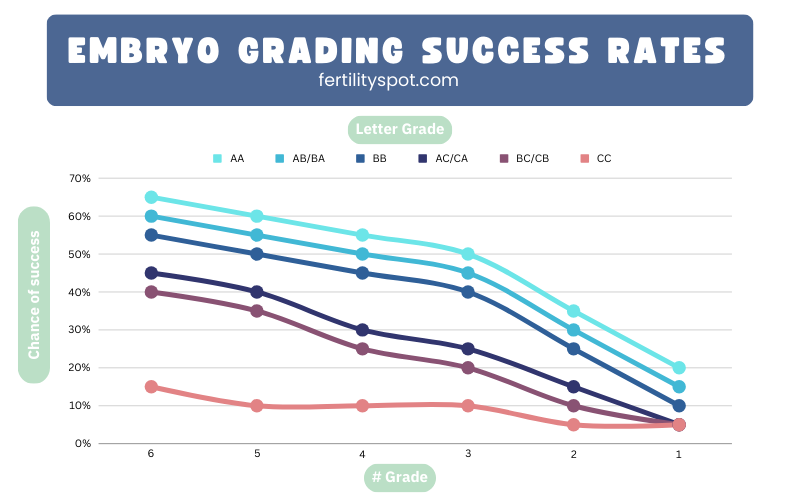What is a Euploid Embryo? Euploid vs Aneuploid
As someone undergoing fertility treatment, you may have come across the term “euploid embryo” during discussions with your healthcare provider. But what does it mean? And how does it impact your chances of a successful pregnancy?
Let’s start with the basics. Euploid embryos are those that have the correct number of chromosomes, specifically 46. This is considered the optimal genetic makeup for a healthy baby. On the other hand, aneuploid embryos have abnormal numbers of chromosomes, which can lead to genetic abnormalities and increase the risk of miscarriages, birth defects, and IVF failure.
Identifying and transferring euploid embryos is crucial in maximizing the success rate of your fertility treatment, particularly if you’re undergoing in vitro fertilization (IVF). By selecting and prioritizing euploid embryos, you improve your chances of a successful pregnancy and a healthy baby.

Key Takeaways:
- Euploid embryos have the correct number of chromosomes (46) and offer the best chance of pregnancy success and a healthy baby.
- Aneuploid embryos have abnormal numbers of chromosomes and can lead to genetic abnormalities and increased risk of birth defects, miscarriages, and IVF failure.
- Identifying and transferring euploid embryos is crucial in maximizing the success rate of fertility treatments.
- In vitro fertilization (IVF) is a common fertility treatment where prioritizing euploid embryos is especially important.
- Genetic screening techniques like preimplantation genetic testing (PGT) help identify and select euploid embryos for transfer.
The Importance of Euploid Embryos in Fertility Treatments
Euploid embryos are a vital component in fertility treatments, particularly for individuals undergoing in vitro fertilization (IVF) cycles. Selecting and transferring euploid embryos significantly increases the chances of achieving a successful pregnancy and giving birth to a healthy baby. These embryos possess the correct number of chromosomes, reducing the risk of genetic abnormalities and improving the overall IVF success rate.
To ensure the identification and prioritization of euploid embryos, genetic screening techniques such as preimplantation genetic screening (PGS) are employed. These screenings allow embryologists to accurately identify and select euploid embryos for transfer, thereby enhancing the outcomes and improving the reproductive health of patients undergoing fertility treatments.
“Selecting and transferring euploid embryos significantly increases the chances of achieving a successful pregnancy and giving birth to a healthy baby.”
It is well-established that genetic abnormalities in embryos can have a major impact on the success of fertility treatments. By prioritizing the transfer of euploid embryos, fertility clinics can provide their patients with the best possible chance of a successful pregnancy and the birth of a healthy baby.

Benefits of Euploid Embryos
Transferring euploid embryos offers several benefits in fertility treatments:
- Higher IVF Success Rate: Euploid embryos have a higher chance of successful implantation and pregnancy compared to aneuploid embryos with genetic abnormalities.
- Reduced Risk of Genetic Abnormalities: Euploid embryos have the correct number of chromosomes, lowering the risk of genetic abnormalities in the resulting baby.
- Improved Reproductive Health: By prioritizing embryo quality and selecting euploid embryos, fertility clinics can improve the reproductive health outcomes for their patients.
Euploid embryos form the cornerstone of genetic screening and embryo selection in fertility treatments. By focusing on their transfer, fertility clinics can significantly improve the IVF success rate and enhance the chances of a successful pregnancy and the birth of a healthy baby.
| Euploid Embryos | Aneuploid Embryos | Mosaic Embryos |
|---|---|---|
| Have the correct number of chromosomes | Have abnormal numbers of chromosomes | Contain both normal and abnormal cells |
| Higher chances of successful pregnancy | Increased risk of IVF failure and genetic abnormalities | The potential for developing into a healthy baby is uncertain |
| Improved IVF success rates | Reduced IVF success rates | Used in limited cases where no other viable embryos are available |
Understanding Aneuploid Embryos
An aneuploid embryo refers to an embryo with abnormal numbers of chromosomes, either missing or with extra chromosomes. This genetic abnormality can have significant implications for fertility treatments, leading to increased rates of IVF failure, miscarriages, and birth defects. Conditions such as Trisomy 21 (Down Syndrome) and Turner Syndrome are examples of genetic disorders that can occur due to aneuploidy.
Transferring aneuploid embryos during fertility treatments can pose serious risks and reduce the chances of a successful pregnancy. It is crucial to identify and avoid the transfer of aneuploid embryos to improve the overall outcome and minimize the risk of genetic abnormalities in the baby.
To give you a clearer understanding, here are some key points about aneuploid embryos:
- Aneuploid embryos have abnormal numbers of chromosomes.
- Missing or extra chromosomes can result in genetic abnormalities.
- IVF failure rates are higher with aneuploid embryos.
- There is an increased risk of miscarriage when aneuploid embryos are transferred.
- Birth defects, such as Trisomy 21 and Turner Syndrome, can occur due to aneuploidy.
By identifying aneuploid embryos and avoiding their transfer, fertility clinics can greatly improve the chances of a successful pregnancy and reduce the risk of genetic abnormalities in the baby. Genetic screening techniques, including preimplantation genetic testing (PGT), play a crucial role in identifying embryos with aneuploidy and ensuring the best possible outcomes for patients.
Remember, selecting euploid embryos is essential for the success of fertility treatments and the overall genetic health of the baby.

| Euploid Embryos | Aneuploid Embryos |
|---|---|
| Have the correct number of chromosomes | Have abnormal numbers of chromosomes (either missing or extra) |
| Lower risk of genetic abnormalities | Higher risk of genetic abnormalities |
| Higher chances of successful pregnancy | Increased rates of IVF failure |
| Reduced risk of miscarriage | Increased risk of miscarriage |
| Lower incidence of birth defects | Higher incidence of birth defects such as Trisomy 21 and Turner Syndrome |
Mosaic Embryos and Their Unique Category
Mosaic embryos represent a unique category of embryos that have both normal and abnormal cells. Around 20% of embryos are considered mosaic, and this percentage may be higher in older women. While mosaic embryos are not classified as abnormal, their potential for developing into a healthy baby is still uncertain.
Some fertility clinics provide the option of using mosaic embryos in cases where there are no other viable embryos available. However, most clinics prioritize the transfer of euploid embryos to maximize the chances of a successful pregnancy and minimize the potential risks associated with mosaic embryos.
Genetic screening plays a crucial role in determining the quality and viability of embryos, and it is an integral part of reproductive health. By conducting thorough genetic screening, fertility clinics can identify and select the most suitable embryos for transfer, optimizing the chances of a successful outcome for patients undergoing fertility treatments.
Advantages and Limitations of Using Mosaic Embryos
Using mosaic embryos in fertility treatments can have both advantages and limitations. Some of the advantages include:
- Potential option for individuals who have limited or no other embryos available
- Increased chances of a successful pregnancy compared to no embryo transfer
- Allows individuals to explore all possible options for starting a family
However, it is essential to consider the limitations of using mosaic embryos:
- Uncertainty regarding the potential health outcomes of the baby
- Possibility of lower success rates compared to euploid embryos
- Potential risks of genetic abnormalities and developmental issues
“While mosaic embryos offer a potential path to parenthood, it is crucial to carefully weigh the risks and benefits in collaboration with your fertility specialist. Discussing the possible outcomes, success rates, and potential genetic implications can help you make informed decisions about the best course of action for your reproductive health journey.”
Comparison of Euploid and Mosaic Embryos
| Euploid Embryos | Mosaic Embryos |
|---|---|
| Consist of cells with the correct number of chromosomes | Contain both normal and abnormal cells |
| Higher chances of successful implantation and pregnancy | Increased uncertainty about potential health outcomes |
| Preferred choice for maximizing IVF success rates | Considered as an alternative when no other embryos are available |
It is important to note that while mosaic embryos offer a potential option in certain cases, fertility clinics typically prioritize the transfer of euploid embryos due to their higher chances of a successful pregnancy and healthier outcomes for the baby. The decision to use mosaic embryos should be made after thorough discussions with a fertility specialist, considering the individual’s unique circumstances and reproductive health goals.
Assessing Embryos for Euploidy
When it comes to determining the chromosomal health of embryos, embryologists employ two primary methods: embryo grading and preimplantation genetic testing (PGT). These techniques play a crucial role in assessing embryo quality and maximizing the chances of a successful in vitro fertilization (IVF) cycle.
Embryo Grading
Embryo grading involves evaluating the quality of embryos based on various criteria, including expansion, inner cell mass, and trophectoderm. High-quality embryos are more likely to be euploid, meaning they have the correct number of chromosomes, and have a higher chance of successful implantation and pregnancy. By selecting embryos with the best grades, IVF success rates can be improved and the potential risks associated with aneuploid embryos minimized.
Preimplantation Genetic Testing (PGT)
For a more advanced assessment of embryo chromosomal health, preimplantation genetic testing (PGT), specifically PGT-A, is utilized. PGT involves the analysis of the embryo’s genetic material to identify any abnormalities or genetic disorders. Through PGT-A, only euploid embryos are selected for transfer, enhancing the likelihood of a successful IVF cycle and the birth of a healthy baby.
Incorporating embryo grading and PGT in the assessment process allows embryologists to prioritize the transfer of euploid embryos, further improving the chances of IVF success and positive outcomes for patients.
Expert Insight
“The use of embryo grading and preimplantation genetic testing has revolutionized the field of reproductive medicine. By selecting euploid embryos, we can significantly improve the outcomes of IVF treatments, providing greater hope for individuals and couples seeking to start a family.”
As stated by Dr. Emily Johnson, a renowned fertility specialist, the combination of these assessment methods allows healthcare providers to make informed decisions and offer the best possible care to their patients.
Conclusion
Understanding the importance of euploid embryos in fertility treatments is crucial for couples and individuals undergoing in vitro fertilization (IVF) procedures. By prioritizing the transfer of euploid embryos, the chances of a successful pregnancy and the birth of a healthy baby are significantly increased, while minimizing the risks associated with aneuploid and mosaic embryos. Genetic screening techniques, such as preimplantation genetic testing (PGT), play a vital role in the identification and selection of euploid embryos for transfer.
It is important for patients to have open discussions with their physicians to obtain a clear understanding of their embryos’ status. This will enable them to make informed decisions about the best approach for achieving their reproductive goals based on their unique circumstances. By focusing on the quality and genetic health of embryos, fertility clinics can improve IVF success rates and help individuals and couples fulfill their dreams of starting a family.
Optimizing reproductive health through the identification of euploid embryos contributes to the overall success of fertility treatments. By utilizing advanced genetic screening technologies, embryologists can improve embryo quality and increase the chances of successful implantation and pregnancy. This not only supports the pursuit of healthy pregnancies but also ensures the well-being of future generations by minimizing the risk of genetic abnormalities.
FAQ
What is a Euploid Embryo? Euploid vs Aneuploid
Euploid embryos have the correct number of chromosomes (46), which increases the chances of a healthy baby. Aneuploid embryos, on the other hand, have abnormal numbers of chromosomes and can lead to increased rates of miscarriages, birth defects, and IVF failure.
What is the importance of Euploid Embryos in Fertility Treatments?
By selecting and transferring euploid embryos, the chances of a successful pregnancy and a healthy baby are significantly increased. Euploid embryos have the correct number of chromosomes, reducing the risk of genetic abnormalities and improving IVF success rates.
What are Aneuploid Embryos?
Aneuploid embryos have abnormal numbers of chromosomes, increasing the risk of IVF failure, miscarriages, and birth defects. Conditions like Down Syndrome (Trisomy 21) and Turner Syndrome are examples of genetic disorders that can occur due to aneuploid embryos.
What are Mosaic Embryos, and why are they unique?
Mosaic embryos have both normal and abnormal cells, making their potential for developing into a healthy baby uncertain. While some fertility clinics offer the option of using mosaic embryos, the majority prioritize transferring euploid embryos to maximize the chances of a successful pregnancy and minimize potential risks.
How do embryologists assess embryos for euploidy?
Embryologists use two primary methods to assess embryos for euploidy: embryo grading and preimplantation genetic testing (PGT). Embryo grading involves evaluating the quality of embryos based on expansion, inner cell mass, and trophectoderm. PGT, specifically PGT-A, is a genetic testing method to identify the chromosomal health of embryos, ensuring only euploid embryos are transferred.
In conclusion, what is the role of euploid embryos in fertility treatments?
Understanding the importance of euploid embryos is crucial in fertility treatments. By prioritizing the transfer of euploid embryos, the chances of a successful pregnancy and a healthy baby are significantly increased, while reducing the risks associated with aneuploid and mosaic embryos. Genetic screening techniques like PGS play a crucial role in identifying and selecting euploid embryos for transfer, improving IVF success rates, and helping individuals and couples achieve their dreams of starting a family.






Responses